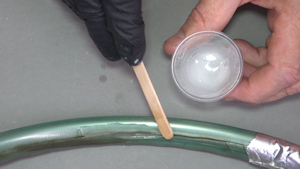We help people repair plastic
Steering Wheel Restoration
Instructional Video
Step-by-Step Instructions

Many cars from the 1950's and 1960's were made from hard plastic that is molded over steel. Over time, these steering wheels develop cracks and splits. We used Polyvance's PlastiFix Kit to restore this steering wheel since PlastiFix works well with hard plastics. If you have a cracked steering wheel that is in need of restoration, we will show you step-by-step how to use PlastiFix (and other Polyvance products) for plastic steering wheel restoration. Restoring a plastic steering wheel is simple, but very time consuming. The step-by-step instructions to repair and restore a cracked steering wheel are shown below, but it is just an overview. There is much more information in the steering wheel restoration video above.
For this repair, we used the following Polyvance products.
- Super Prep plastic cleaner
- Plastic Magic adhesion promoter
- PlastiFix kit (We used "clear")
- Hardset Filler
- All Seasons E-Z Waterborne Primer Surfacer (Light Gray)
- All Seasons Waterborne Sealer (White)
- Aluminum Tape
You will also need:
- Sandpaper in the following grits: 80 grit, 180 grit, 240 grit, 320 grit, and 400 grit
- Rubber Gloves
- Plastic Body Filler Spreaders
- Sanding block(s).
- Dremel Tool
- Automotive Paint
- Oscillating Tool
Helpful, but not necessary.
Step-By-Step Instructions
Step 1
Clean the cracked steering wheel with Polyvance's Super Prep plastic cleaner and a paper towel. Wear gloves on this step to protect your skin from the plastic cleaner.
Step 2
Get the PlastiFix liquid and powder ready to apply by following the instructions that are INSIDE the label. Fill the liquid applicator bottle and the powder cup.
Step 3
Fill in every crack, gap and void in the steering wheel that you can find. In a later step, you will be able to find the ones that you missed.
Step 4
Another technique is to use the mixing cup that doesn’t have a lid and mix up a small batch of PlastiFix and trowel it on. Pour some powder into the cup. Next, pour some liquid into the cup and mix it together with the popsicle stick. You may need to add more liquid or powder to get the right consistency. Use the popsicle stick to trowel the mixture into the cracks in the steering wheel. There isn’t a lot of working time before the mixture gets too thick, so work quickly.
Step 5
Now it is time to start sanding. This is the most time consuming part. Get different grit sandpaper, sanders, and sanding blocks to get it as smooth as possible.
Step 6
These cracks in the steering wheel are tiny and not too deep, so it will be quicker to fill it in with Polyvance’s hardset epoxy filler. Once the filler cures, continue sanding.
Step 7
After all of the sanding is complete, get the steering wheel ready for primer by taping off what you don’t want to get painted. Even though you may think you have the steering wheel really smooth, the primer will help you see the imperfections.
Step 8
We used a cheap lazy susan to make the painting easier. You can do it without one, though. We used a roll of tape to elevate the steering wheel. Spray the steering wheel with Plastic Magic adhesion promoter and wait for it to dry before turning over the steering wheel and spraying Plastic Magic on the opposite side. Use Polyvance’s E-Z Sand Waterborne Primer Surfacer and spray the entire steering wheel. This is a high-build primer that will fill in sand scratches.
Step 9
Once the primer dries, you will see the areas that still need work.
Step 10
Use a Dremel tool to widen the gaps in the steering wheel a little bit. This will give the PlastiFix more surface area to bond to.
Step 11
Fill in the gaps in the steering wheel with more PlastiFix, allow it to cure, and then sand it all smooth. Use progressively finer grit sandpaper until it is smooth. We used the profile sanding blocks from an oscillating tool to sand inside-corners and radiused corners. Cutting sandpaper into narrow strips is helpful, too. Once everything is sanded, clean the steering wheel with Super Prep plastic cleaner and apply Plastic Magic adhesion promoter to get it ready for sealer.
Step 12
Use Polyvance’s All-Seasons Waterborne sealer and spray the entire steering wheel. Fill any remaining scratches and pinholes with spot putty and sand them smooth until it is ready for paint. Get some automotive paint in the color you need. We used a single stage urethane paint.
Step 13
We applied the paint using a touch up gun since the surfaces needing paint were so narrow, and it worked out well, too. We allowed the paint to cure for about 24 hours and then removed the masking tape.
Step 14
Reinstall the steering wheel, and you are done!
😎
Search terms: steering wheel repair kit ,
This page was created on September 09, 2019
sterring wheel repair steering wheel
Products Used For This Repair















